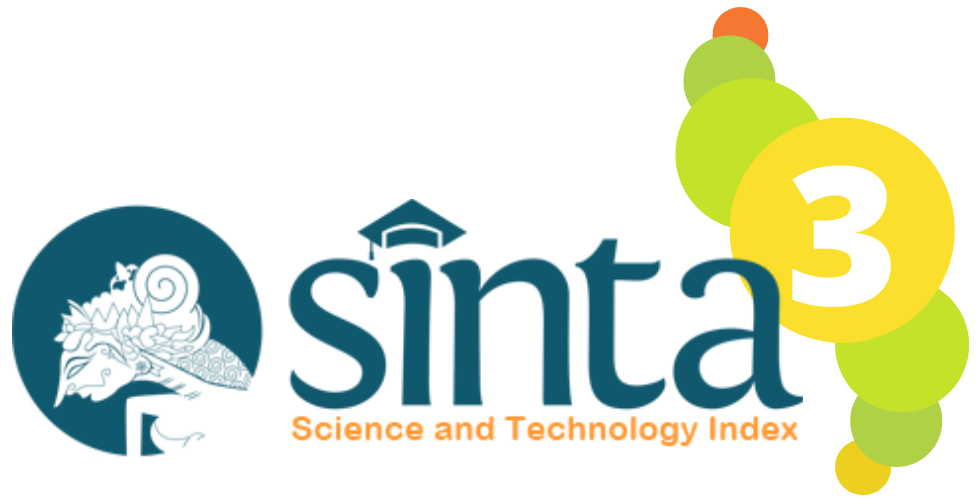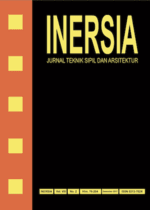Effectiveness of Concrete Crack Repair Using Bacillus subtilis and Calcium Lactate
DOI:
https://doi.org/10.21831/inersia.v21i1.71313Keywords:
Bacillus subtilis, Calcite, Calcium lactate, Concrete crack, Self-healing concreteAbstract
Cracks facilitate aggressive substances entering the steel easily and cause corrosion of the reinforcement. There are several innovative methods for dealing with cracks in concrete, one of which is using bacteria. The purpose of using bacteria and CaL is to find out the role and effectiveness of repairing cracks in concrete. In outline, several methods and tests are carried out, including bacterial culture, test tube, concrete sample making, concrete curing, compressive strength testing, permeability testing, absorption testing, image processing testing, and microscopic testing. The test tube results showed that the highest mass of calcite was found in a solution of 2 ml of bacteria and CaL with a concentration of 65.4 g/L. The cracks appeared closed visually at 28 days of age. Through imageJ software, the crack repair rate in concrete reaches 95.94%. The effect of adding B. subtilis and CaL was proven to be able to close concrete cracks and increase the compressive strength of cracked concrete by 13.16%, reduce permeability by 53.12%, and absorption by 22.20%. This was confirmed by SEM testing and VHX-7000 observations which showed the presence of calcite crystals in the concrete pores and filled the concrete crack areas. This study elucidated that using bacillus subtilis bacteria and calcium Lactate in self-healing concrete is an effective technique to repair the concrete crack.
References
[1] J. Xu, Y. Tang, X. Wang, Z. Wang, and W. Yao, “Application of ureolysis-based microbial CaCO3 precipitation in self-healing of concrete and inhibition of reinforcement corrosion,” Constr. Build. Mater., vol. 265, 2020.
[2] K. Vijay and M. Murmu, “Effect of calcium lactate and Bacillus subtilis on properties of concrete and self-healing of cracks,” J. Struct. Eng., vol. 10, no. 3, 2020.
[3] H. A. Algaifi, S. A. Bakar, A. R. M. Sam, A. R. Z. Abidin, S. Shahir, and W. A. H. Al-Towayti, “Numerical modeling for crack self-healing concrete by microbial calcium carbonate,” Constr. Build. Mater., vol. 189, pp. 816–824, 2018.
[4] K. W. Shah and G. F. Huseien, “Biomimetic self-healing cementitious construction materials for smart buildings,” Biomimetics, vol. 5, no. 4, pp. 1–22, 2020.
[5] K. Vijay and M. Murmu, “Effect of calcium lactate on compressive strength and self-healing of cracks in microbial concrete,” Front. Struct. Civ. Eng., vol. 13, no. 3, pp. 515–525, 2019.
[6] S. Sangadji and E. Schlangen, “Mimicking bone healing process to self repair concrete structure novel approach using porous network concrete,” Procedia Eng., vol. 54, pp. 315–326, 2013.
[7] D. Silva, F. Gameiro, and J. de Brito, “Mechanical properties of structural concrete containing fine aggregates from waste generated by the marble quarrying industry,”
J. Mater. Civ. Eng., vol. 26, no. 6, pp. 1–8, 2013.
[8] A. El-Newihy, P. Azarsa, R. Gupta, and A. Biparva, “Effect of polypropylene fibers on self-healing and dynamic modulus of elasticity recovery of fiber reinforced concrete,” Fibers, vol. 6, no. 1, 2018.
[9] S. Muhammad and H. A. Siddiqui, “Bacillus subtilis as self-healing agent in cement mortar: The effect of curing time and amount of calcium lactate on strength,” Mehran Univ. Res. J. Eng. Technol., vol. 40, no. 4, pp. 889–897, 2021.
[10] V. Wiktor and H. M. Jonkers, “Quantification of crack-healing in novel bacteria-based self-healing concrete,” Cem. Concr. Compos., vol. 33, no. 7, pp. 763–770, 2011.
[11] H. M. Jonkers, A. Thijssen, G. Muyzer, O. Copuroglu, and E. Schlangen, “Application of bacteria as self-healing agent for the development of sustainable concrete,” Ecol. Eng., vol. 36, no. 2, pp. 230–235, 2010.
[12] H. A. Algaifi et al., “Bio-inspired self-healing of concrete cracks using new B. pseudomycoides species,” J. Mater. Res. Technol., vol. 12, pp. 967–981, 2021.
[13] C. Neeladharan, J. Sharpudin, V. Loganath, B. Jagan, C. Chinnarasu, and K. R. Vijaykaran, “Application of Bacillus subtilis for improving properties and healing of cracks in concrete,” Int. J. Adv. Res. Trends Eng. Technol., vol. 5, no. 5, 2018.
[14] ASTM, “Standard test method for organic impurities in fine aggregates for concrete,” ASTM C40-20, 2011.
[15] Badan Standarisasi Nasional, “Cara uji sifat kekekalan agregat dengan cara perendaman menggunakan larutan natrium sulfat atau magnesium sulfat,” SNI 3407:2008, 2008.
[16] Badan Standarisasi Nasional, “Spesifikasi bahan bangunan,” SK SNI 2-04-1989-F, 1989.
[17] Badan Standarisasi Nasional, “Cara uji berat jenis dan penyerapan air agregat halus,” SNI 1970:2008, 2008.
[18] ASTM, “Standard specification for concrete aggregates,” ASTM C33-86, 2010.
[19] Badan Standarisasi Nasional, “Metode pengujian kadar air agregat,” SNI 1971:1990, 1990.
[20] Badan Standarisasi Nasional, “Cara uji berat jenis dan penyerapan air agregat kasar,” SNI 1969:2008, 2008.
[21] Badan Standarisasi Nasional, “Cara uji keausan agregat dengan mesin abrasi Los Angeles,” SNI 2417:2008, 2008.
[22] R. A. Zulfikar, H. Putra, and H. Yasuhara, “Utilization of soybean as catalyst material in enzyme-mediated calcite precipitation for crack healing concrete,” J. Civ. Eng. Forum, 2021.
[23] M. A. R. Elmahdy, A. A. Elshami, E. S. M. Yousry, and S. S. E. Ahmad, “Self-healing mortar using different types, content, and concentrations of bacteria to repair cracks,” Frat. Ed Integrita Strutt., vol. 16, no. 59, pp. 486–513, 2021.
[24] Suriani and M. Amran, “Prospect of Bacillus subtilis as a biological control agent of soilborne pathogens on maize,” J. Penelit. Pengemb. Pertan., vol. 35, no. 1, pp. 37–45, 2016.
[25] J. Feng, B. Chen, W. Sun, and Y. Wang, “Microbial induced calcium carbonate precipitation study using Bacillus subtilis with application to self-healing concrete,” Constr. Build. Mater., vol. 280, 2021.
[26] S. Luhar, I. Luhar, and F. U. A. Shaikh, “A review on the performance evaluation of autonomous self-healing bacterial concrete: mechanisms, strength, durability, and microstructural properties,” J. Compos. Sci., vol. 6, no. 1, 2022.
[27] J. M. Irwan et al., “Calcium lactate addition in bioconcrete: Effect on compressive strength and water penetration,” MATEC Web Conf., vol. 78, 2016.
[28] R. Siddique, V. Nanda, K. M. Iqbal, M. Singh, and A. Rajor, “Influence of bacteria on compressive strength and permeation properties of concrete made with cement baghouse filter dust,” Constr. Build. Mater., 2016, pp. 461–469.
[29] B. M. S. Reddy and D. Revathi, “An experimental study on effect of Bacillus sphaericus in crack filling and strength enhancement of concrete,” Mater. Today Proc., vol. 19, pp. 803–809, 2019.
[30] Z. M. Hussein, A. H. Abedali, and A. S. Ahmead, “Improvement properties of self-healing concrete by using bacteria,” IOP Conf. Ser. Mater. Sci. Eng., vol. 584, no. 1, 2019.
[31] Q. T. Phung, N. Maes, G. De Schutter, D. Jacques, and G. Ye, “Determination of water permeability of cementitious materials using a controlled constant flow method,” Constr. Build. Mater., vol. 47, pp. 1488–1496, 2013.
[32] N. Chahal, R. Siddique, and A. Rajor, “Influence of bacteria on the compressive strength, water absorption and rapid chloride permeability of fly ash concrete,” Constr. Build. Mater., vol. 28, no. 1, pp. 351–356, 2012.
[33] S. Shahid, M. A. Aslam, M. Ali, Z. Zameer, and M. Faisal, “Self-healing of cracks in concrete using Bacillus strains encapsulated in sodium alginate beads,” ChemistrySelect, vol. 5, no. 1, pp. 312–323, 2020.
[34] S. H. A. Sabah et al., “The use of calcium lactate to enhance the durability and engineering properties of bioconcrete,” Sustain., vol. 16, no. 13, 2021.
[35] S. Tao and Y. Yumei, “Quantitative analysis of ettringite formed in the hydration products of high-alite cements,” Adv. Cem. Res., vol. 27, no. 9, pp. 497–505, 2015.
Downloads
Published
How to Cite
Issue
Section
License
Copyright (c) 2025 Heriansyah Putra

This work is licensed under a Creative Commons Attribution 4.0 International License.
Authors who publish with INERSIA journal agree to the following terms:
- Authors retain copyright and grant the INERSIA journal right of first publication with the work simultaneously licensed under Creative Commons Attribution License (CC BY 4.0) that allows others to share the work with an acknowledgment of the work's authorship and initial publication in this journal.
- Authors can enter into separate, additional contractual arrangements for the non-exclusive distribution of the published version of the work (e.g., post it to an institutional repository or edit it in a book), with an acknowledgment of its initial publication in this journal.
- Authors are permitted and encouraged to post their work online (e.g., in institutional repositories or on their website) before and during the submission process, as it can lead to productive exchanges, as well as earlier and greater citation of published work.

INERSIA by https://journal.uny.ac.id/index.php/inersia was distributed under a Creative Commons Attribution 4.0 International License











